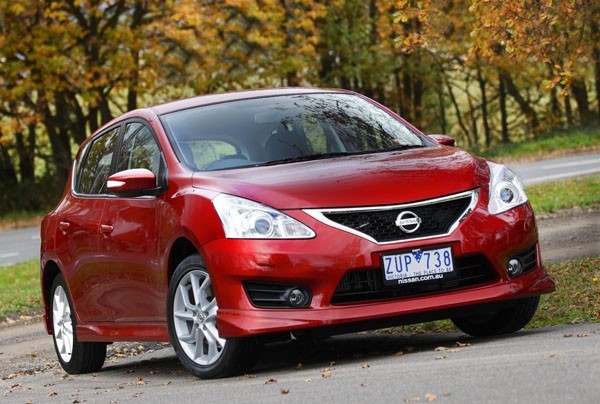New Nissan Pulsar hatch has joined its sedan sibling that arrived here in February, finally putting an end to the era of the capable but sadly misunderstood Nissan Tiida.
We’ve told the story on numerous occasions of the big sales slump that followed on from the decision by Nissan Australia’s corporate masters in Japan to replace the Pulsar nameplate with the new global Tiida badge. Suffice to say that in the four months that the new Pulsar sedan has been on sale it has already sold nearly twice as many units as the Tiida sedan and hatch combined did in the 2012 calendar year.
Some of this can be explained by the fact that it’s a new model but there’s no question that many Australian buyers have been sweating on the return of the Pulsar badge, and especially with the five-door hatchback body.
Even more keenly anticipated, according to the company’s own research, is the SSS variant which hasn’t been available since 2000. The new Pulsar SSS, that only comes in hatch format, is powered by a modern 1.6-litre turbo-petrol engine with direct injection combined with a single scroll turbocharger and an intercooler. These combine to provide 140 kW of power with peak torque of 240 Nm at 2000 rpm. SSS also gets sports tuned suspension and steering.
In our previous review of the Pulsar sedan we commented on the surprising amount of interior space and this is carried across to the hatch with enough rear leg space and headroom to comfortably sit a pair of six-foot passengers.
There are three other variants in the Pulsar hatch range. The entry level Pulsar ST and the ST-L share the same 96 kW / 174 Nm 1.8-litre petrol engine as the sedan while the ST-S also gets the turbo.
All Pulsar hatches come with the choice of six-speed manual or CVT automatic with the two turbocharged models also getting a manual mode in the CVT.
We were able to sample each of the new Pulsar hatch models during the launch test drive in and around the Yarra Valley to the north of Melbourne. The 1.8 pulled smoothly from as low as 1500 rpm and strongly from 2500 revs. Handling is competent enough, without having any pretensions to sportiness.
Nissan was one of the early adopters of CVT transmissions and the Pulsar hatch has what Nissan calls Smooth Start Assist control which reduces the sounds which have turned off some drivers. As it’s a CVT acceleration is super smooth and the strong torque of the engine lets the transmission hold onto high ratios when climbing all but the steepest of hills.
Ride comfort is reasonable with moderate tyre noise on all but coarse-chip surfaces, with the Pulsar being particularly smooth and quiet on good quality motorways.
Expectations were high for the new Pulsar SSS and it didn’t disappoint. This is an excellent engine highlighted by a lovely sporting note and with plenty of punch even at low revs. Turbo lag is imperceptible. The manual gearbox is light and smooth while the paddle shifts add variety to the CVT’s operation.
Suspension is firmer than in the other variants without compromising ride comfort while handling and cornering on the wet roads that we encountered were safe with only slight body roll.
In such a competitive market segment pricing is paramount and Nissan was screwed down the price of its entry level manual ST to $18,990, a thousand less than the equivalent sedan.
Equipment levels are modest in the ST and although it does include Bluetooth telephone you need to get up to the flagship SSS if you want audio streaming. Indeed even a USB socket is missing from the ST which relies on its CD slot or Auxiliary input for entertainment.
Safety equipment is good with all models having six airbags, ABS brakes with brake assist and electronic brakeforce distribution; stability and traction control; and cruise control.
The $22,490 ST-L adds front foglights; rear spoiler; USB socket; 4.3-inch colour display; and a rear seat centre armrest. The ST-S Turbo ($24,990) gets 17-inch alloy wheels compared to 16-inch in the ST and ST-L. The extra $4000-odd for the SSS buys a modest body kit; xenon headlights; 5.8-inch touch screen; satellite navigation; Bluetooth audio streaming; reversing camera; leather-accented seat trim; and push-button engine start.
CVT adds $2250 to the price of the ST and ST-L and $2500 to that of the ST-S and SSS.
All the above prices are recommended retail and do not include on-road costs which Nissan Australia estimates at between $2900 and $3100 depending upon the model.
For years Nissan fans have been clamouring for the return of the Pulsar and in particular the SSS so we’d be very surprised if dealers aren’t in for a hectic time.
If the impressive early sales of the sedan are anything to go by then the new Pulsar hatch may even challenge the Toyota Corolla and Mazda3 in the sales race.
The full range of the 2013 Nissan Pulsar is:
ST 1.8-litre four-door sedan: $19,990 (manual), $22,240 (CVT automatic)
ST-L 1.8-litre four-door sedan: $23,650 (manual), $25,900 (CVT automatic)
Ti 1.8-litre four-door sedan: $28,990 (CVT automatic)
ST 1.8-litre five-door hatch: $18,990 (manual), $21,240 (CVT automatic)
ST-L 1.8-litre five-door hatch: $22,490 (manual), $24,740 (CVT automatic
ST-S 1.6-litre turbo-petrol five-door hatch: $24,990 (manual), $27,490 (CVT automatic)
SSS 1.6-litre turbo-petrol five-door hatch: $29,240 (manual), $31,740 (CVT automatic)
Note: These prices do not include government or dealer delivery charges. Contact your local Nissan dealer for drive away prices.
